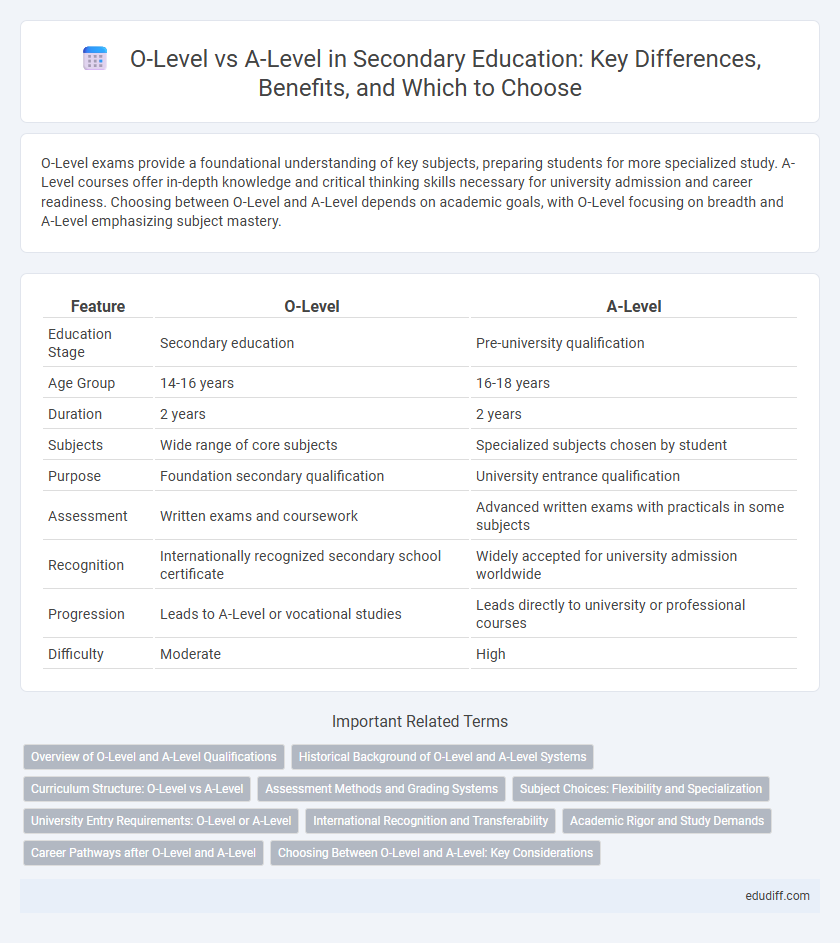O-Level exams provide a foundational understanding of key subjects, preparing students for more specialized study. A-Level courses offer in-depth knowledge and critical thinking skills necessary for university admission and career readiness. Choosing between O-Level and A-Level depends on academic goals, with O-Level focusing on breadth and A-Level emphasizing subject mastery.
Table of Comparison
| Feature | O-Level | A-Level |
|---|---|---|
| Education Stage | Secondary education | Pre-university qualification |
| Age Group | 14-16 years | 16-18 years |
| Duration | 2 years | 2 years |
| Subjects | Wide range of core subjects | Specialized subjects chosen by student |
| Purpose | Foundation secondary qualification | University entrance qualification |
| Assessment | Written exams and coursework | Advanced written exams with practicals in some subjects |
| Recognition | Internationally recognized secondary school certificate | Widely accepted for university admission worldwide |
| Progression | Leads to A-Level or vocational studies | Leads directly to university or professional courses |
| Difficulty | Moderate | High |
Overview of O-Level and A-Level Qualifications
O-Level (Ordinary Level) qualifications serve as foundational secondary school certifications, typically covering a broad range of subjects and assessing students' grasp of essential knowledge and skills. A-Level (Advanced Level) qualifications are more specialized and rigorous, usually undertaken after O-Levels, focusing on in-depth study in specific subjects to prepare students for higher education or professional pathways. Both qualifications are internationally recognized, with O-Levels providing the groundwork for A-Level studies, which are critical for university admissions and career advancement.
Historical Background of O-Level and A-Level Systems
The O-Level and A-Level systems originated from the British education framework established in the mid-20th century, designed to standardize secondary education assessments. O-Levels, introduced in the 1950s, served as the first major examination at the end of compulsory schooling, while A-Levels developed later to provide advanced subject specialization for university entrance. These systems became globally recognized, influencing educational structures in various Commonwealth countries.
Curriculum Structure: O-Level vs A-Level
O-Level curriculum provides a broad foundation with compulsory subjects like Mathematics, Sciences, and Languages, emphasizing foundational knowledge and skills over two years. A-Level curriculum is more specialized, allowing students to focus intensively on 3 to 4 subjects, fostering depth of understanding in preparation for university education. The structured progression from O-Level breadth to A-Level specialization supports academic development tailored to career aspirations.
Assessment Methods and Grading Systems
O-Level assessments primarily use structured written exams with multiple-choice and short-answer questions that evaluate foundational knowledge in subjects like Mathematics and Science. A-Level grading emphasizes analytical skills and in-depth understanding, assessed through essay-style exams and practical projects, often resulting in letter grades from A* to E. The O-Level grading system focuses on numerical scores converted into grades like A to C, while A-Level results are critical for university admissions due to their rigorous evaluation of critical thinking and subject mastery.
Subject Choices: Flexibility and Specialization
O-Level offers a broad range of subjects, providing flexibility for students to explore various disciplines before specializing. A-Level focuses on in-depth study of fewer subjects, allowing for greater specialization tailored to future academic or career goals. This structure supports students in developing expertise in their chosen fields while maintaining foundational knowledge.
University Entry Requirements: O-Level or A-Level
University entry requirements often prioritize A-Level qualifications for advanced subject knowledge and critical thinking skills needed in higher education. While O-Level provides a foundational understanding, A-Level results are typically essential for meeting competitive university admissions criteria and specific course prerequisites. Many universities recognize A-Levels as a standard for eligibility, reflecting their role in assessing academic readiness for tertiary studies.
International Recognition and Transferability
A-Levels hold broader international recognition compared to O-Levels, often serving as a prerequisite for university admission worldwide. Many universities in the UK, Australia, Canada, and Singapore acknowledge A-Levels as equivalent to high school completion, facilitating seamless academic transfer. O-Levels primarily demonstrate foundational secondary education but are less frequently accepted for direct university entry or international credit transfers.
Academic Rigor and Study Demands
A-Levels demand higher academic rigor, with in-depth subject specialization compared to the broader O-Level curriculum. Students face increased study demands due to complex concepts and extensive coursework required for university preparation. Mastery of critical thinking, analytical skills, and independent learning is essential for success at the A-Level stage.
Career Pathways after O-Level and A-Level
O-Level completion opens pathways to vocational training, diploma courses, and entry-level employment opportunities in fields such as hospitality, retail, and technical trades. A-Level graduates gain eligibility for university admissions and professional courses, facilitating careers in medicine, engineering, law, and business management. Choosing A-Levels significantly enhances prospects for specialized higher education and competitive job markets demanding advanced qualifications.
Choosing Between O-Level and A-Level: Key Considerations
Choosing between O-Level and A-Level courses requires evaluating academic goals and subject preferences, where O-Level offers a broader foundation and A-Level emphasizes specialization in subjects relevant to university entrance. Consideration of future career paths and university requirements is essential, as A-Levels are generally preferred for competitive university admissions globally. Balancing workload intensity and personal strengths helps students select the most suitable pathway for secondary education advancement.
O-Level vs A-Level Infographic

 edudiff.com
edudiff.com